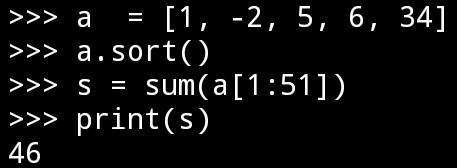Предмет: Информатика,
автор: ustinatkachenko
7. Що надрукує програма? a = [1, -2, 5, 6, 34] a.sort() S = sum(a[1:51) print(s)
Ответы
Автор ответа:
1
Ответ:
46
Объяснение:
В прикреплённом файле.
Приложения:

Похожие вопросы
Предмет: Русский язык,
автор: анна123457
Предмет: Русский язык,
автор: анечка103
Предмет: Английский язык,
автор: ferhusder
Предмет: Физика,
автор: ukrtaizer
Предмет: Математика,
автор: vovil2007